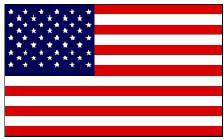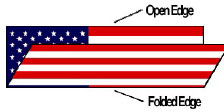The American flag has a long history, and the members of our organization have spent nearly as long defending and honoring our nation's most iconic symbol of freedom. Whether you're looking for the historic details of how the U.S. flag came to be, or the rules and regulations that encompass her daily flight, we're here to ensure you can find the information you need.
-
Displaying the Flag
On Same Staff
U.S. flag at peak, above any other flag.
Grouped
U.S. flag goes to its own right. Flags of other nations are flown at same height.
Marching
U.S. flag to marchers right (observer's left).
On Speaker's Platform
When displayed with a speaker's platform, it must be above and behind the speaker. If mounted on a staff it is on the speaker's right.
Decoration
Never use the flag for decoration. Use bunting with the blue on top, then white, then red.
Salute
All persons present in uniform should render the military salute. Members of the armed forces and veterans who are present but not in uniform may render the military salute. All other persons present should face the flag and stand at attention with their right hand over the heart, or if applicable, remove their headdress with their right hand and hold it at the left shoulder, the hand being over the heart.
Over a Street Union (stars) face north or east depending on the direction of the street.
Half Staff
On special days, the flag may be flown at half-staff. On Memorial Day it is flown at half-staff until noon and then raised.Special Rules
Do not let the flag touch the ground.
Do not fly flag upside down unless there is an emergency.
Do not carry the flag flat, or carry things in it.
Do not use the flag as clothing.
Do not store the flag where it can get dirty.
Do not use it as a cover.
Do not fasten it or tie it back. Always allow it to fall free.
Do not draw on, or otherwise mark the flag.Illumination Guidelines
Per Federal Flag Code, Section 2, paragraph (a), it is the universal custom to display the flag only from sunrise to sunset on buildings and on stationary flagstaffs in the open. However, when a patriotic effect is desired, the flag may be displayed twenty-four hours a day if properly illuminated during the hours of darkness. -
POW/MIA Protocol
The POW/MIA flag features a silhouette of a POW before a guard tower and barbed wire in white on a black field. "POW/MIA” appears above the silhouette and the words "You Are Not Forgotten” appear below in white on the black field. This black and white flag stands as a stark reminder of Americans still prisoner, missing or otherwise unaccounted for in Southeast Asia and is now accepted nationally and internationally as the symbol of vigilance and remembrance for all POW and MIA’s.
Order of Precedence in the Display of the POW/MIA Flag
All flags flying on the same pole with the U.S. flag will be subordinate to the U.S. flag. The question frequently arises about what flag (POW/MIA, state, organization, etc.) has precedence to be flown directly beneath the U.S. flag and above any other flag. There is no definitive answer or protocol established in writing or codified in law. It is VFW protocol, since the POW/MIA flag is considered a federal banner, that the POW/MIA flag has precedence over all other flags flying on the same pole beneath the U.S. flag. In a line of march, the POW/MIA flag is carried to the immediate left of the U.S. flag. The VFW views the POW/MIA issue as a matter of national importance first, thereby giving the POW/MIA flag a position of prominence.
For the full protocol for displaying the POW/MIA Flag, visit the National League of POW/MIA Families website.
-
Flag Disposal
1. The flag should be folded in its customary manner.
2. It is important that the fire be fairly large and of sufficient intensity to ensure complete burning of the flag.
3. Place the flag on the fire.
4. The individual(s) can come to attention, salute the flag, recite the Pledge of Allegiance and have a brief period of silent reflection.
5. After the flag is completely consumed, the fire should then be safely extinguished and the ashes buried.
6. Please make sure you are conforming to local/state fire codes or ordinances.
Note: There is a box in the front entrance of the Post that you may put your flag in for proper flag disposal.
-
Official U.S. Flag Code
Public Law 94-344, known as the Federal Flag Code, contains rules for handling and displaying the U.S. flag. While the federal code contains no penalties for misusing the flag, states have their own flag codes and may impose penalties. The language of the federal code makes clear that the flag is a living symbol.
In response to a Supreme Court decision which held that a state law prohibiting flag burning was unconstitutional, Congress enacted the Flag Protection Act in 1989. It provides that anyone who knowingly desecrates the flag may be fined and/or imprisoned for up to one year. However, this law was challenged by the Supreme Court in a 1990 decision that the Flag Protection Act violates the First Amendment free speech protections. Access the U.S. Flag Code Guide.
-
Order of Precedence
The order of precedence when displaying military flags together is Army, Marine Corps, Navy, Air Force and Coast Guard. -
Correct Method of Folding the U.S. Flag
Start

Step 1

Fold the lower striped section of the flag over the blue field.
Step 2

Folded edge is then folded over to meet the open edge.
Step 3

A triangular fold is then started by bringing the striped corner of the folded edge to the open edge.
Step 4

Outer point is then turned inward parallel with the open edge to form a second triangle.
Step 5

Triangular folding is continued until the entire length of the flag is folded in the triangular shape with only the blue field visible.
Completed

-
U.S. Flag History
Old Glory
The name "Old Glory" was first applied to the U.S. flag by a young sea captain who lived in Salem, Mass. On his 21st birthday, March 17, 1824, Capt. William Driver was presented a beautiful flag by his mother and a group of Salem girls. Driver was delighted with the gift and named the flag "Old Glory." Old Glory accompanied the captain on his many sea voyages. In 1837 he quit sailing and settled in Nashville. On patriotic days he displayed Old Glory proudly from a rope extending from his house to a tree across the street.
After Tennessee seceded from the Union in 1861, Captain Driver hid Old Glory, sewing it inside a comforter. When the Union soldiers entered Nashville on February 25, 1862, Driver removed Old Glory from its hiding place. He carried the flag to the capitol building and raised it above the state capitol. Shortly before his death, the old sea captain placed a small bundle into the arms of his daughter. He said to her: "Mary Jane, this is my ship's flag, Old Glory. It has been my constant companion. I love it as a mother loves her child. Cherish it as I have cherished it."
The flag remained as a precious heirloom in the Driver family until 1922. It was then sent to the Smithsonian Institution in Washington D.C., where it is carefully preserved under glass.Betsy Ross
Who designed the original "Stars and Stripes" flag of the United States is a point never definitely confirmed. Was it Betsy Ross, expert Philadelphia seamstress, or New Jersey's Congressman Francis Hopkinson?
The traditional story that Betsy Ross designed the original flag in 1776 has caught the popular fancy but no official record substantiates the story. Some historians claim that in June 1776, Gen. George Washington, Robert Morris and Betsy's uncle, George Ross, went to her Philadelphia upholstery shop. The men told her they were members of a congressional committee. They showed her a rough design of a stars and stripes flag and asked her if she would make the emblem. She said yes and recommended making the stars five-pointed instead of six. The change was approved.
George Washington drew another design, and Betsy Ross sewed the emblem. On June 14, 1777, Congress adopted it as the official U.S. flag. That is the Betsy Ross story as it is related. However, some sources claim there is no official record of a congressional flag committee. The only documented evidence naming Mrs. Ross is said to be a voucher dated May 29, 1777, showing that she was paid 14 pounds and some shillings for flags she made for the Pennsylvania Navy.
Note: Recent historic research indicates Francis Hopkinson, a consultant to the Second Continental Congress is responsible for designing the original Stars and Stripes.Our National Anthem
For more than a century the "Star Spangled Banner," written by Francis Scott Key in 1814, was sung as a popular patriotic air. From time to time Army and Navy leaders designated it as the national anthem for official occasions. In 1916 President Woodrow Wilson proclaimed it the national anthem. Continuous lobbying by the Veterans of Foreign Wars led to Congress designating the song as the official national anthem of the United States on March 3, 1931.
Francis Scott Key practiced law in Baltimore during the War of 1812. In 1814 one of Key's friends, Dr. Beanes, was held prisoner by the British aboard the ship Minden in Baltimore harbor. Key decided he would try to obtain his friend's release. Carrying a flag of truce and a letter from President James Madison, Key rowed out to the ship. His request for the friend's freedom was granted, but both men were detained onboard because the British were about to bombard Fort McHenry.
During the bombardment, Key watched the Stars and Stripes flying over the fort. Darkness fell, and he no longer could see the flag. But the fort kept on firing back at the British, so Key knew the American stronghold had not surrendered.
When daylight returned Key was overjoyed to see that "the flag was still there." Taking an old envelope from his pocket he wrote the stirring opening words," O say, can you see by the dawn's early light, what so proudly we hailed at the twilight's last gleaming, whose broad stripes and bright stars, through the perilous fight, o'er the ramparts we watched, were so gallantly streaming?"
After he returned ashore, Key completed the verse, which was later published in the Baltimore American, September 21, 1814. It became popular immediately. Later the words were set to the English "Anacreon in Heaven," which is the tune we sing today.
